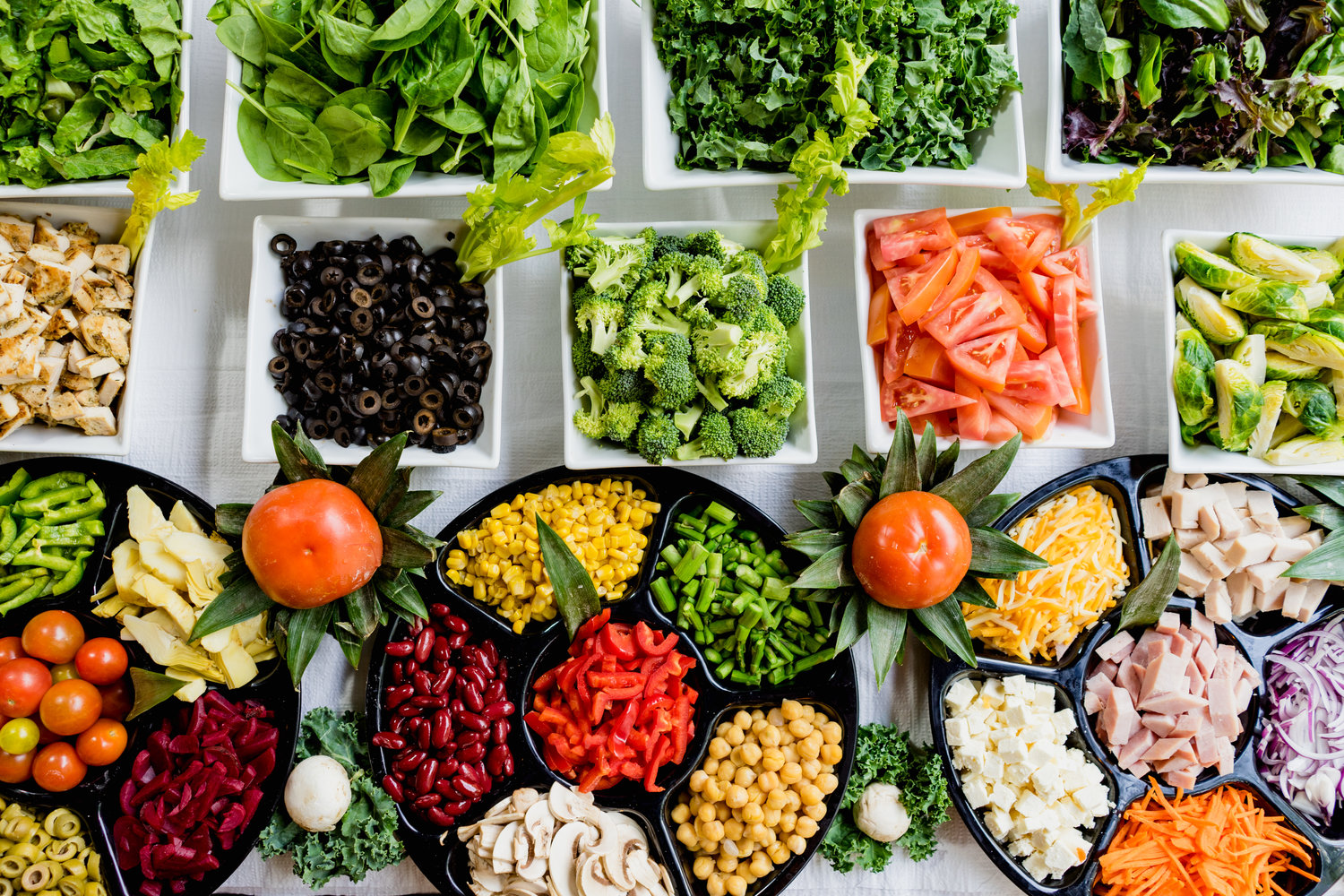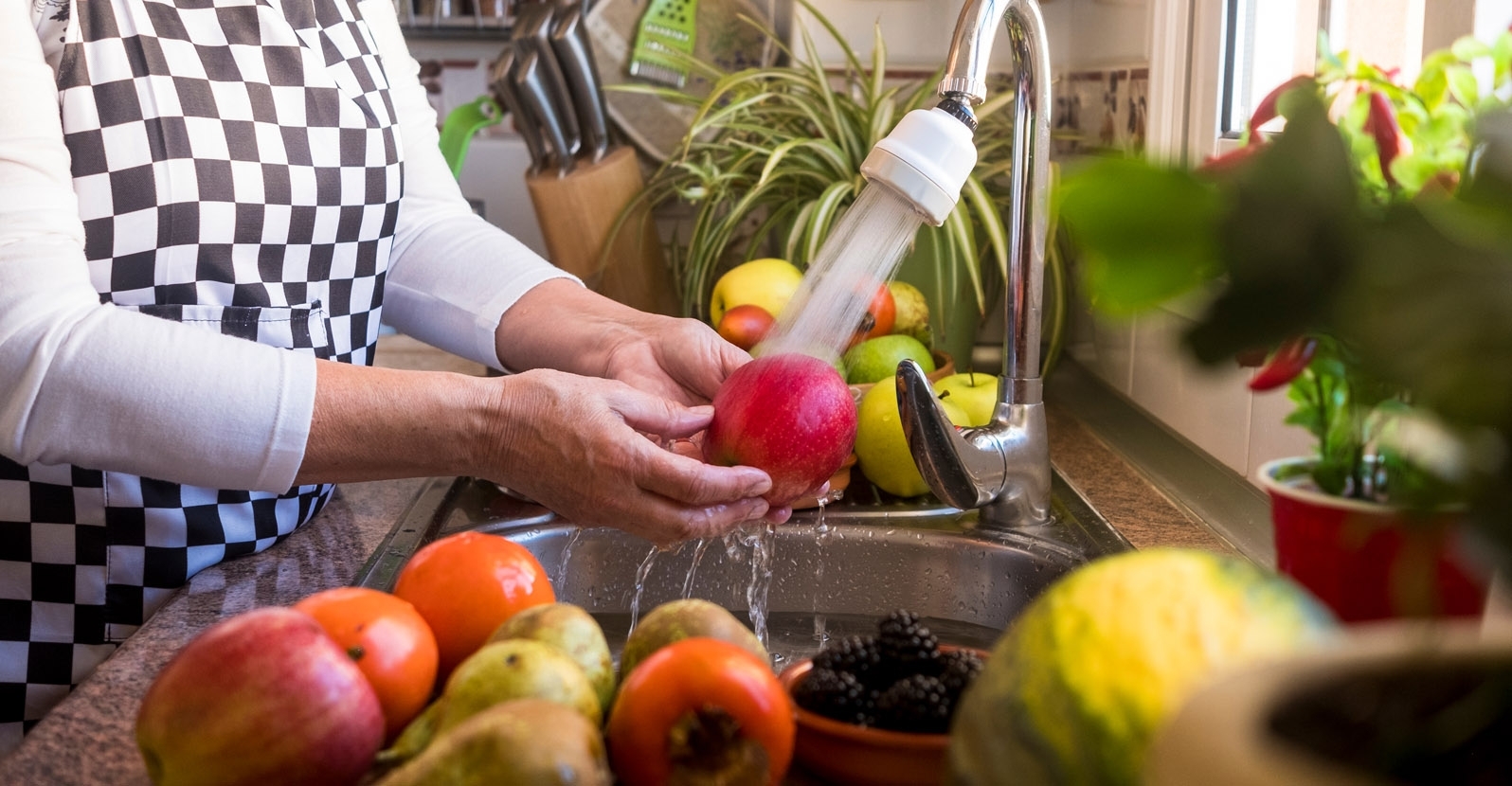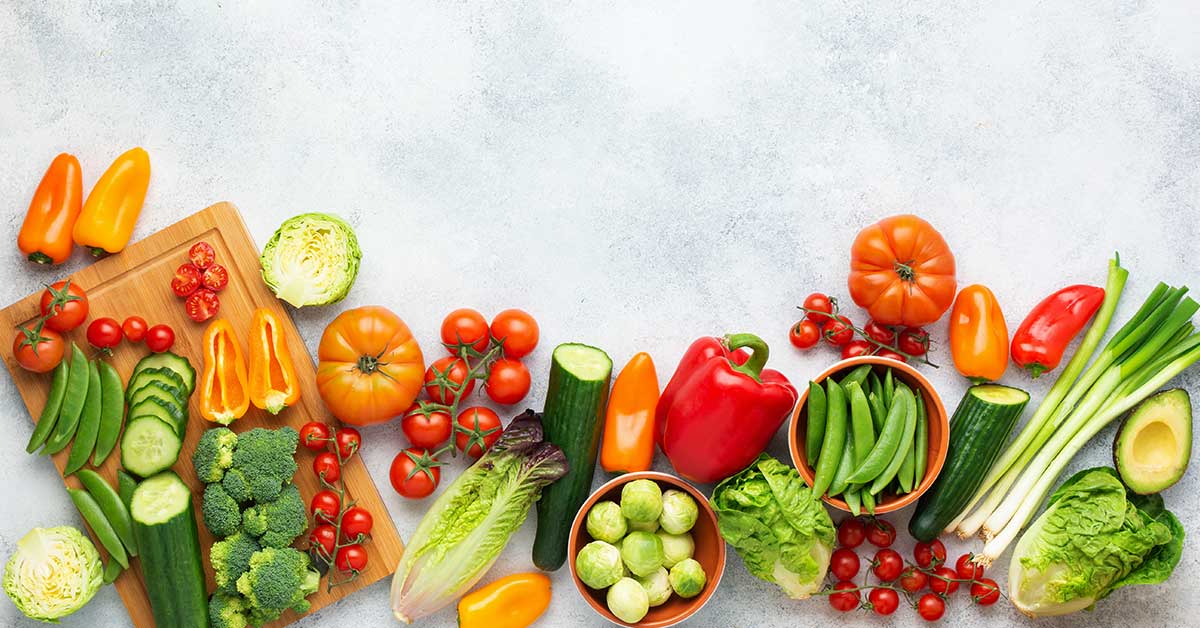Home>Gardening News and Trends>Latest News>How To Get More Vegetables In Your Diet


Latest News
How To Get More Vegetables In Your Diet
Modified: January 22, 2024
Discover the latest news and learn how to incorporate more vegetables into your diet with our helpful tips and recipes. Start living a healthier lifestyle today!
(Many of the links in this article redirect to a specific reviewed product. Your purchase of these products through affiliate links helps to generate commission for Chicagolandgardening.com, at no extra cost. Learn more)
Table of Contents
- Introduction
- The Importance of Adding More Vegetables to Your Diet
- Tips for Incorporating Vegetables into Your Meals
- Start with Small Changes
- Experiment with Different Cooking Methods
- Sneak Vegetables into Your Favorite Dishes
- Plan Your Meals in Advance
- Explore New Recipes and Flavors
- Make Vegetables the Star of Your Plate
- Take Advantage of Seasonal Produce
- Get Creative with Salads and Veggie Bowls
- Stock Your Pantry with Healthy Vegetable Options
- Seek Inspiration from Others
- Conclusion
Introduction
Welcome to the world of healthy eating! If you’re looking to improve your diet and make a positive change in your lifestyle, adding more vegetables to your meals is a great place to start. Vegetables are packed with essential nutrients, vitamins, and fiber, making them a crucial component of a well-rounded diet. However, many people struggle to incorporate enough veggies into their daily meals.
Don’t worry, though; with a little planning and creativity, you can easily increase your vegetable intake and reap the countless benefits they offer. Whether you’re a picky eater or simply looking for new ways to amp up your meals, this article will provide you with practical tips and strategies to help you get more vegetables into your diet.
By following these guidelines, you’ll not only improve your overall health but also discover a whole new world of flavors and textures. So, let’s dive into the wonderful world of vegetables and learn how to make them a delicious and essential part of our everyday meals!
The Importance of Adding More Vegetables to Your Diet
Vegetables are often referred to as “nature’s multivitamin” for a good reason. They are loaded with essential nutrients that are vital for our overall health and well-being. Incorporating more vegetables into your diet brings a multitude of benefits, from boosting your immune system to improving digestion and promoting healthy weight management. Let’s explore why adding more vegetables to your meals is so important:
- Nutrient Powerhouses: Vegetables are packed with essential vitamins, minerals, and antioxidants. They provide an array of nutrients like vitamin C, vitamin A, potassium, folate, and fiber, which are essential for the proper functioning of our bodies.
- Reduced Disease Risk: Eating a variety of vegetables has been linked to a lower risk of chronic diseases, including heart disease, stroke, certain types of cancer, and obesity. The antioxidants present in vegetables help combat free radicals and inflammation, reducing the risk of oxidative stress and related health problems.
- Weight Management: Vegetables are low in calories and high in fiber, which can help you feel fuller for longer and prevent overeating. Including them in your meals can contribute to weight management by reducing calorie intake and promoting a healthy body weight.
- Improved Digestion: The high fiber content in vegetables aids digestion and promotes regular bowel movements. It can prevent constipation and promote a healthy gut microbiome, which is crucial for overall digestive health.
- Increased Energy and Vitality: The nutrients in vegetables provide the energy our bodies need to function optimally. Eating a diet rich in vegetables can help reduce fatigue, improve mood, and increase overall vitality and well-being.
- Stronger Immune System: Vegetables are packed with immune-boosting nutrients like vitamin C and phytochemicals. They help strengthen our immune system, protecting us against illnesses and infections.
With all these incredible benefits, it’s clear that adding more vegetables to your diet is a smart and crucial decision for your overall health. Now, let’s dive into some practical tips on how to incorporate more vegetables into your meals and make them a delicious part of your everyday routine!
Tips for Incorporating Vegetables into Your Meals
Adding more vegetables to your meals doesn’t have to be a daunting task. With a little creativity and a few simple strategies, you can easily amp up the nutritional value of your dishes. Here are some practical tips to help you incorporate more vegetables into your meals:
- Start with Small Changes: Begin by making small, gradual changes to your meals. Add a handful of spinach to your omelet or mix some grated zucchini into your pasta sauce. These small additions won’t drastically alter the taste of your dishes but will add extra nutrients.
- Experiment with Different Cooking Methods: Try out various cooking methods to find ones that enhance the flavor and texture of vegetables. Roasting, grilling, or stir-frying vegetables can bring out their natural sweetness and add a delicious smoky flavor.
- Sneak Vegetables into Your Favorite Dishes: Get creative and sneak vegetables into your favorite dishes. Puree cooked vegetables and add them to sauces, soups, or stews. You won’t even notice they’re there, but you’ll benefit from the added nutrients.
- Plan Your Meals in Advance: Plan your meals ahead of time and make sure to include a variety of vegetables in your menu. Having a well-thought-out meal plan will increase the likelihood of incorporating vegetables into your meals.
- Explore New Recipes and Flavors: Don’t be afraid to try new recipes and flavors. Explore different cuisines that incorporate a wide range of vegetables, such as Mediterranean or Asian dishes. This will introduce you to new flavors and diversify your vegetable choices.
- Make Vegetables the Star of Your Plate: Instead of treating vegetables as a side dish, make them the main attraction. Build your meal around vegetables, adding grains, proteins, and sauces to complement their flavors.
- Take Advantage of Seasonal Produce: Seasonal produce is not only fresher and more flavorful but also more affordable. Visit your local farmer’s market or grocery store and choose vegetables that are in season. Incorporating seasonal produce into your meals will bring variety and freshness to your plate.
- Get Creative with Salads and Veggie Bowls: Salads and veggie bowls are a fantastic way to showcase a variety of vegetables. Mix different types of greens, add colorful veggies, and top with nuts, seeds, or a homemade dressing for a satisfying and nutritious meal.
- Stock Your Pantry with Healthy Vegetable Options: Keep your pantry stocked with frozen, canned, or dehydrated vegetables. These options are convenient and can be added to meals or used as emergency backups when fresh vegetables aren’t available.
- Seek Inspiration from Others: Look for inspiration from cookbooks, food blogs, or social media accounts that focus on vegetable-based recipes. You’ll find plenty of creative ideas and techniques that will make incorporating vegetables into your meals exciting and enjoyable.
By following these practical tips, you’ll be well on your way to increasing your vegetable intake and enjoying the many health benefits they provide. Don’t be afraid to experiment and have fun with your meals – the possibilities are endless!
Start with Small Changes
When it comes to incorporating more vegetables into your meals, starting small is key. Gradually making changes to your eating habits allows for a smoother transition and increases the likelihood of long-term success. Here are some simple steps to get you started:
Swap Out Ingredients: Begin by swapping out some of the ingredients in your favorite recipes with vegetables. For example, instead of using regular pasta, try zucchini noodles or spaghetti squash. Replace half of the meat in your dishes with finely chopped mushrooms or lentils to add extra texture and nutrients.
Add Vegetables to Familiar Dishes: Another way to start small is by adding vegetables to familiar dishes. For instance, include some chopped bell peppers, onions, and tomatoes to your scrambled eggs or incorporate them into your homemade pizza toppings. By doing so, you’ll add color, flavor, and a boost of nutrition to your meals.
Blend Vegetables into Smoothies: Smoothies are a fantastic way to pack a punch of nutrients. Add a handful of spinach or kale to your fruit smoothies for an extra dose of vitamins and minerals. The sweetness of the fruits will help mask the taste of the vegetables, making it an easy and delicious way to include more veggies in your diet.
Sneak Veggies into Sauces and Soups: Pureeing vegetables and adding them to sauces and soups is a clever way to amp up the nutritional content of your meals. Blend cooked carrots or butternut squash into your pasta sauce or mix pureed cauliflower into your mashed potatoes. These additions not only increase the vegetable content but also enhance the creaminess and flavor of the dish.
Try Veggie Snacks: Swap your usual snack choices with vegetable-based alternatives. Instead of reaching for a bag of chips, opt for carrot sticks with hummus or cucumber slices with Greek yogurt dip. These snack options are not only nutritious but also provide additional hydration and fiber.
Explore New Vegetable Varieties: Expand your vegetable horizons by trying new varieties. Explore your local farmer’s market or grocery store and choose options you haven’t tasted before. This will introduce you to different flavors and textures, making your meals more exciting and diverse.
Remember, the goal is to make sustainable changes that you can maintain in the long run. Starting with small changes and gradually increasing your vegetable intake will lead to a healthier and more balanced diet. So, don’t be afraid to take that first step and enjoy the wonderful world of vegetables!
Experiment with Different Cooking Methods
When it comes to incorporating more vegetables into your meals, exploring different cooking methods can make a world of difference. Not only does it add variety to your dishes, but it also brings out the unique flavors and textures of the vegetables. Here are some cooking methods to try:
Roasting: Roasting vegetables in the oven brings out their natural sweetness and enhances their flavors. Toss chopped vegetables with olive oil, salt, and your choice of seasonings, then spread them out on a baking sheet and roast at a high temperature until golden and slightly caramelized. The result is a deliciously tender and slightly crispy vegetable dish.
Grilling: Grilling vegetables gives them a smoky and charred flavor that can elevate your meals. Cut your favorite vegetables into thick slices or kebab-sized pieces, brush them with oil, sprinkle with seasonings, and grill on medium-high heat until nicely charred and tender. Grilled vegetables are perfect for summer barbecues or as a side dish for grilled meats.
Stir-Frying: Stir-frying is a quick and versatile cooking method that retains the crispness and vibrant colors of vegetables. Heat a small amount of oil in a wok or skillet, add your choice of vegetables (such as bell peppers, broccoli, and snap peas), and cook on high heat, stirring constantly until the vegetables are tender-crisp. Finish with a flavorful sauce for a delicious stir-fry dish.
Steaming: Steaming vegetables is a gentle cooking method that preserves their nutrients and natural flavors. Place a steamer basket in a pot filled with a small amount of water. Add your vegetables, cover the pot, and steam until they are tender but still retain some bite. Steamed vegetables are a great option for those who prefer a lighter and more delicate taste.
Sautéing: Sautéing vegetables in a hot pan with a small amount of oil or butter quickly cooks them while retaining their color and texture. Heat the oil or butter in a skillet over medium-high heat, add your vegetables, and toss them periodically until they are tender and slightly browned. Sautéed vegetables are a versatile addition to pasta, rice, or grain bowls.
Blanching: Blanching involves briefly boiling vegetables and then plunging them into ice water to stop the cooking process. This method helps retain the vegetables’ vibrant colors and crispness. Blanching is particularly useful when preparing vegetables for salads, stir-fries, or freezing, as it helps to maintain their texture and color.
Slow Cooking: Slow cooking is ideal for root vegetables like potatoes, carrots, and turnips. This method involves low and slow cooking in a crockpot or a Dutch oven, allowing the flavors to meld together and the vegetables to become tender and flavorful. Slow-cooked vegetables are perfect for hearty stews, soups, and casseroles.
By experimenting with different cooking methods, you can discover new flavors and textures that will make eating vegetables exciting and enjoyable. Don’t be afraid to get creative and find the cooking technique that suits your taste preferences and dietary needs. So, grab your apron, pick a cooking method, and start transforming simple vegetables into delicious culinary creations!
Sneak Vegetables into Your Favorite Dishes
One of the best ways to increase your vegetable intake is by sneaking them into your favorite dishes. This strategy is perfect for those who may have picky eaters at home or those who want to boost the nutritional value of their meals without compromising on flavor. Here are some creative ways to sneak vegetables into your favorite dishes:
Add Purees to Sauces: Pureeing vegetables and adding them to sauces is a fantastic way to pack a nutritional punch. Blend cooked cauliflower, butternut squash, or carrots and mix them into your pasta or pizza sauce. Not only does this method add extra nutrients, but it also creates a creamy and rich sauce without the need for heavy cream or butter.
Use Veggie Noodles: Replace traditional pasta with vegetable-based noodles to reduce your carb intake and increase your veggie consumption. Spiralize zucchini, carrots, or sweet potatoes to create delicious and nutritious alternatives to spaghetti or noodles. These veggie noodles can be enjoyed raw, sautéed, or lightly steamed and topped with your favorite sauces or dressings.
Blend Veggies into Smoothies: Smoothies are a fantastic way to enjoy the goodness of vegetables, especially for those who are not fond of eating them. Blend a handful of spinach or kale into your fruit smoothies, along with some yogurt or plant-based milk. The sweetness of the fruits masks the taste of the vegetables, making it a great way to sneak in some extra greens and nutrients.
Include Veggies in Casseroles and Bakes: Add finely chopped or grated vegetables to casseroles, lasagnas, and baked dishes. Mix veggies like bell peppers, carrots, and mushrooms into the meat filling or layer them between the sheets of pasta. Not only do they add nutritional value, but they also bring a pop of color and texture to your comfort food favorites.
Replace Half the Meat: Often, you can reduce the amount of meat in a recipe and replace it with veggies without compromising on taste. For example, if you’re making burgers or meatballs, substitute half of the ground meat with finely chopped mushrooms or mixed vegetables. This adds moisture, flavor, and nutrients while reducing the overall calorie and fat content of the dish.
Top Pizzas with Veggies: Instead of loading your pizza with only cheese and meat, add an abundance of veggies as well. Top your pizza with colorful vegetables like peppers, onions, spinach, and mushrooms, and sprinkle some herbs and spices for added flavor. The combination of cheesy goodness and vibrant veggies will make your pizza a nutritious and delicious meal.
Stuff Veggies with Savory Fillings: Hollowed-out vegetables can be filled with delicious savory fillings and baked until tender. For example, stuff bell peppers with a mixture of quinoa, black beans, and corn, or fill zucchinis with a combination of ground meat, onions, and spices. This method allows you to enjoy the flavors of your favorite fillings while increasing your veggie intake.
By sneaking vegetables into your favorite dishes, you can effortlessly add nutritional value to your meals without sacrificing taste. Get creative and experiment with different combinations to find the perfect balance between flavor and health benefits. So, don’t be afraid to transform your beloved recipes into veggie-packed delights!
Plan Your Meals in Advance
Planning your meals in advance is a powerful strategy to ensure you have a variety of vegetables in your daily diet. By taking the time to plan, you can make sure that your meals are balanced, nutritious, and filled with a colorful array of veggies. Here are some tips to help you effectively plan your meals:
Create a Weekly Meal Plan: Set aside some time each week to create a meal plan. Consider your schedule, the number of servings you’ll need, and the vegetables you want to incorporate. Plan for a mix of different dishes, including breakfasts, lunches, dinners, and snacks, and make sure each meal includes a serving of vegetables.
Make a Shopping List: Once you’ve determined your meal plan, create a shopping list that includes all the vegetables you’ll need for the week. Take stock of what you already have in your pantry and then write down the fresh produce you want to purchase. This way, you’ll have everything you need on hand and won’t be tempted to skip the vegetables while grocery shopping.
Prep Your Vegetables in Advance: Spend some time prepping your vegetables after grocery shopping or during meal prep sessions. Wash, chop, and store them in airtight containers in the refrigerator. This makes it easy to quickly add them to meals throughout the week, saving you time and ensuring you don’t skip them due to convenience.
Batch Cook and Freeze: Consider batch cooking large quantities of vegetable-based dishes and freezing them in individual portions. Soups, stews, and casseroles packed with vegetables freeze well and can be easily reheated for a quick and nutritious meal when you’re short on time. Having these pre-made meals on hand ensures you always have a vegetable-rich option available.
Repurpose Leftovers: Get creative with leftovers by turning them into new meals with added vegetables. For example, leftover roasted vegetables can be added to a frittata or tossed into a salad. Shredded cooked chicken or beef can be mixed with chopped veggies and wrapped in lettuce leaves for a refreshing and nutritious wrap.
Use a Meal Planning App: Utilize technology by using a meal planning app or website to help with your planning. These tools often provide recipe suggestions and allow you to schedule your meals, create shopping lists, and track your vegetable intake. They can be a convenient and organized way to ensure you’re incorporating vegetables into your meals consistently.
By planning your meals in advance, you set yourself up for success in incorporating vegetables into your daily diet. It takes the guesswork out of what to cook and ensures that you have the necessary ingredients on hand. So, start meal planning and enjoy the benefits of a well-balanced and vegetable-rich diet!
Explore New Recipes and Flavors
One of the best ways to incorporate more vegetables into your diet is by exploring new recipes and flavors. Trying out different cuisines and experimenting with innovative recipes can open up a world of possibilities when it comes to incorporating vegetables in exciting and delicious ways. Here’s how you can expand your culinary horizons:
Explore Different Cuisines: Each cuisine has its unique way of incorporating vegetables. Explore cuisines like Mediterranean, Indian, Thai, or Middle Eastern, which are known for their abundant use of vegetables and flavorful spice combinations. These cuisines offer a wide variety of vegetable-based dishes that will tantalize your taste buds and introduce you to new flavors and cooking techniques.
Follow Vegetable-Focused Cookbooks and Websites: Seek inspiration from cookbooks and websites that focus on vegetable-based recipes. There are numerous resources available that provide creative and innovative ideas for incorporating vegetables into your meals. These recipes often feature exciting flavor combinations and inventive cooking methods that can help you elevate your vegetable dishes.
Experiment with Different Vegetables: Step out of your comfort zone and try vegetables you’ve never tasted before. Visit your local farmer’s market or grocery store and pick up a vegetable that catches your eye. Research different ways to prepare it and experiment with new recipes. By adding a variety of vegetables to your meals, you’ll introduce more diverse nutrients into your diet.
Opt for Plant-Based Protein Sources: Incorporating plant-based protein sources, such as legumes, tofu, tempeh, or seitan, in your meals opens up a world of possibilities for vegetable-based dishes. Experiment with recipes that combine these protein sources with an abundance of vegetables, herbs, and spices to create flavorful and nutritious meals.
Try New Cooking Techniques: Besides exploring new recipes, try different cooking techniques to add variety to your vegetable dishes. For example, try grilling vegetables for a smoky flavor, blanching them for salads, or pickling them for a tangy twist. These techniques can transform the taste and texture of vegetables, making them more exciting and enjoyable.
Join a Community Cooking Group: Engage with a community cooking group or challenge to explore new recipes and flavors together. This can provide a support system, inspire creativity, and encourage you to try new vegetable-based dishes. Share your experiences, swap recipes, and learn from fellow cooking enthusiasts.
Exploring new recipes and flavors is a fun and adventurous way to incorporate more vegetables into your meals. So be curious, step outside your comfort zone, and embrace the culinary possibilities that await you. Your taste buds and your health will thank you!
Make Vegetables the Star of Your Plate
One of the best ways to ensure you’re getting enough vegetables in your diet is by making them the star of your plate. By shifting the focus from meat or grains to a variety of colorful and nutritious vegetables, you can create visually appealing, flavorful, and satisfying meals. Here’s how you can make vegetables the highlight of your plate:
Create Veggie-Centric Meals: Build your meals around vegetables by making them the main component. Instead of centering your plate around a meat or starch, start with a bed of leafy greens or roasted vegetables and add smaller portions of protein and grains. This allows you to enjoy a variety of flavors and textures while ensuring that vegetables take center stage.
Experiment with Veggie-based Burgers and Patties: Replace traditional meat-based burgers with veggie-based alternatives. Experiment with homemade bean patties, lentil burgers, or portobello mushroom caps as the base. These options provide a hearty and flavorful alternative that allows you to showcase a variety of vegetables in a satisfying and delicious way.
Embrace Meatless Meals: Dedicate specific days or meals as “meatless” where you focus solely on vegetable-based dishes. Explore cuisines like vegetarian Indian, Middle Eastern, or Mediterranean, which have an abundance of flavorful and satisfying vegetarian options. Use vegetables as the main protein source by incorporating legumes, tofu, tempeh, or seitan for added nutrition and texture.
Create Vibrant and Colorful Salads: Salads are an excellent canvas for showcasing a variety of vegetables. Combine different types of lettuce, spinach, kale, or arugula with a colorful assortment of veggies such as tomatoes, cucumbers, bell peppers, and radishes. Add additional toppings like nuts, seeds, dried fruits, and a sprinkle of cheese or feta to create a visually stunning and nutrient-packed salad.
Build Flavorful Veggie Bowls: Veggie bowls are a popular trend for a reason – they allow you to combine a variety of vegetables, grains, proteins, and sauces in a customizable and visually appealing way. Start with a base of quinoa, brown rice, or cauliflower rice and layer on roasted or sautéed vegetables, protein of your choice, and a flavorful sauce. Top it off with fresh herbs, seeds, or nuts for added texture and flavor.
Explore Vegetable Stuffed Dishes: Get creative with vegetable-stuffed options to make vegetables the star of the show. Stuff bell peppers, zucchinis, or tomatoes with a mixture of grains, protein, and flavorful vegetables. Bake until tender and enjoy a satisfying and veggie-packed meal.
Invest in Spiralizers and Vegetable Gadgets: Investing in kitchen tools like spiralizers or vegetable slicers allows you to transform vegetables into fun and exciting shapes. Create zoodles (zucchini noodles), sweet potato noodles, or beet noodles as a replacement for traditional pasta. These gadgets make it easy to incorporate more vegetables into your meals while adding an element of fun to the cooking process.
Making vegetables the star of your plate not only increases your vegetable intake but also provides a variety of nutrients, flavors, and textures. By prioritizing vegetables, you’ll discover a whole new world of culinary possibilities and enjoy the delicious benefits of a plant-centric diet.
Take Advantage of Seasonal Produce
When it comes to incorporating more vegetables into your meals, one of the best strategies is to take advantage of seasonal produce. Choosing vegetables that are in season not only ensures their freshness but also offers an abundance of flavors and nutritional benefits. Here’s why you should embrace seasonal produce and how to make the most of it:
Freshness and Flavor: Seasonal vegetables are harvested at their peak, ensuring optimal freshness and flavor. They are allowed to ripen naturally, which results in better taste and texture. In contrast, vegetables that are out of season may be harvested early or transported long distances, compromising their quality.
Affordability: Seasonal produce tends to be more affordable compared to out-of-season options. The increased supply of in-season vegetables often leads to lower prices, making it easier to incorporate them into your meals on a regular basis. Buying seasonal produce can be a cost-effective way to enjoy a wide variety of vegetables without breaking the bank.
Nutritional Value: Seasonal vegetables are typically richer in nutritional value. They are harvested at the ideal time when their nutrient content is the highest. Eating a diverse range of seasonal vegetables allows you to enjoy a wide array of vitamins, minerals, and antioxidants, which are essential for maintaining optimal health.
Support Local Farmers: Choosing seasonal produce supports local farmers and contributes to the local economy. By purchasing from farmer’s markets, community-supported agriculture (CSA) programs, or directly from farmers, you not only benefit from fresh and nutritious vegetables but also help sustain local food systems.
Meal Planning Around Seasonal Produce: When planning your meals, take into account the seasonal vegetables available. Stay connected with your local farmer’s market or use online resources to find out what’s in season. Incorporate these vegetables into your meal ideas, ensuring that they take the spotlight in your recipes.
Preserving and Freezing: Take advantage of seasonal abundance by preserving or freezing excess produce. You can blanch and freeze vegetables like peas, corn, or green beans to enjoy them throughout the year. Another option is to make pickles or jams with seasonal vegetables, which can add a burst of flavor to your meals during the off-season.
Try New Recipes: Seasonal vegetables often inspire new culinary possibilities. Explore recipes that highlight specific seasonal vegetables and experiment with different cooking methods and flavor combinations. This allows you to fully appreciate the unique qualities and tastes that each season brings.
By embracing seasonal produce, you not only enjoy the freshest and most flavorful vegetables but also support local farmers and reap the nutritional benefits they offer. So, venture out to your local market, explore what’s in season, and let the bounty of nature inspire your vegetable-filled meals!
Get Creative with Salads and Veggie Bowls
One of the best ways to incorporate more vegetables into your meals is by getting creative with salads and veggie bowls. These versatile dishes not only provide an opportunity to showcase a variety of colorful vegetables but also allow you to play with different flavors, textures, and toppings. Here’s how you can elevate your salads and veggie bowls to make them exciting and satisfying:
Mix and Match Varieties: Start by combining different types of greens for your salad base, such as baby spinach, mixed lettuces, or arugula. Add a variety of colorful vegetables like cherry tomatoes, cucumbers, bell peppers, and radishes to create a visually appealing and nutrient-packed salad.
Add Protein: Include a protein source in your salad or veggie bowl to make it more filling and balanced. Options can include grilled chicken, tofu, chickpeas, lentils, or hard-boiled eggs. These additions add a boost of protein and additional textures to your dish.
Incorporate Whole Grains or Legumes: To make your salad or veggie bowl even more satiating, add a serving of whole grains like quinoa, brown rice, or farro. Alternatively, you can include legumes such as black beans, kidney beans, or lentils. These additions add fiber, protein, and a hearty element to your dish.
Play with Texture: Enhance your salad or veggie bowl by incorporating different textures. Add crunchy elements like toasted nuts, seeds, or croutons. Consider including creamy components like avocado, feta cheese, or goat cheese. The combination of textures will make your dish more satisfying and enjoyable to eat.
Experiment with Dressings and Sauces: Elevate the flavor profile of your salad or veggie bowl by experimenting with homemade dressings and sauces. Make a tangy vinaigrette using fresh herbs, citrus juice, and olive oil. Try a creamy avocado or tahini-based dressing for a rich and luscious mouthfeel. Or, drizzle a flavorful sauce like chimichurri, peanut sauce, or tzatziki to add a burst of flavor.
Get Creative with Toppings: Don’t be afraid to think outside the box when it comes to toppings. Sprinkle some pomegranate seeds for a pop of color and a burst of sweetness. Add a handful of crispy roasted chickpeas for a crunchy element. Toss in some dried fruits like cranberries or apricots for a hint of natural sweetness. The possibilities are endless, so have fun and experiment with unique toppings.
Think Beyond Traditional Salads: Don’t limit yourself to traditional green salads. Experiment with different types of salads like grain salads, pasta salads, or Asian-inspired slaw. These variations provide more diversity in flavors and textures while still offering an abundance of vegetables.
Build Beautiful Veggie Bowls: Veggie bowls are a great way to combine various vegetables, proteins, grains, and sauces in one satisfying meal. Start with your choice of base, such as quinoa, brown rice, or cauliflower rice. Then, layer on roasted or sautéed vegetables, protein of your choice, and drizzle with a flavorful sauce or dressing. Top it off with fresh herbs, seeds, or nuts for added crunch and flavor.
By getting creative with salads and veggie bowls, you can transform a simple bowl of vegetables into a stunning, tasty, and nutrient-packed meal. So, let your imagination run wild, explore new flavors and combinations, and enjoy the endless possibilities that salads and veggie bowls have to offer!
Stock Your Pantry with Healthy Vegetable Options
Stocking your pantry with healthy vegetable options is a smart strategy to ensure that you always have accessible and nutritious choices on hand. Having a well-stocked pantry makes it easier to incorporate vegetables into your meals, even when fresh produce is not readily available. Here are some tips to help you stock your pantry with healthy vegetable options:
Canned Vegetables: Keep a variety of canned vegetables in your pantry, such as canned tomatoes, beans, and corn. These canned options are convenient, have a long shelf life, and are great for adding flavor, nutrients, and texture to your dishes. Look for low-sodium options when available and rinse canned vegetables to reduce the sodium content.
Frozen Vegetables: Frozen vegetables are a convenient alternative to fresh produce. They are often picked and frozen at peak ripeness, preserving their nutrients. Keep a variety of frozen vegetables like peas, broccoli, cauliflower, and mixed vegetables in your freezer. They can be easily incorporated into stir-fries, soups, stews, or roasted dishes, providing you with a quick and nutrition-packed addition to any meal.
Dried Vegetables: Dried vegetables, such as sun-dried tomatoes, dried mushrooms, or dried seaweed, can add intense flavor and texture to your dishes. They are shelf-stable and can be rehydrated when needed. Dried vegetable options are versatile and can be used in pasta dishes, salads, stir-fries, or as toppings for grain bowls.
Veggie Broth or Stock: Having vegetable broth or stock in your pantry is essential for adding depth and flavor to your soups, stews, and sauces. Look for low-sodium or no-added-salt options, or make your own homemade vegetable broth by saving vegetable scraps or peels and boiling them with water and spices.
Seaweed and Nori Sheets: Keeping dried seaweed like nori sheets in your pantry is a great way to add a unique flavor and texture to your meals. Use nori sheets for sushi rolls, chop them up as a topping for salads or bowls, or crumble them into soups or stir-fries for an umami boost.
Vegetable Powders: Vegetable powders are a convenient way to add flavor and nutrients to your dishes. Stock your pantry with options like tomato powder, beetroot powder, or spinach powder. These powders can be used in seasoning blends, sauces, dressings, or added to smoothies for an extra nutrient boost.
Condiments and Sauces: Look for condiments and sauces that have a vegetable base or are made with vegetable ingredients. Opt for options like tomato paste, salsa, marinara sauce, or pesto as flavorful additions to your meals. These condiments and sauces are versatile and can be used in a variety of dishes.
By stocking your pantry with healthy vegetable options, you ensure that you always have access to nutritious choices even when fresh produce may be unavailable. Having these pantry staples on hand allows you to incorporate vegetables into your meals effortlessly and maintain a well-rounded and balanced diet.
Seek Inspiration from Others
When it comes to incorporating more vegetables into your meals, seeking inspiration from others can be a great way to discover new ideas, flavors, and techniques. Whether it’s through cookbooks, food blogs, online communities, or social media accounts, finding inspiration from other individuals can help you explore an array of vegetable-based dishes. Here are some ways you can seek inspiration from others:
Cookbooks and Recipe Collections: Browse through a wide range of cookbooks and recipe collections that focus on vegetable-centric cooking. Look for cookbooks that specialize in plant-based or vegetarian cuisine. These resources often provide a wealth of creative and flavorful recipes that will inspire you to incorporate more vegetables into your meals.
Food Blogs and Websites: Explore food blogs and websites that feature vegetable-focused recipes. Many talented food bloggers share their culinary creations, providing step-by-step instructions and mouthwatering photographs. Follow blogs that align with your dietary preferences, whether it’s vegan, vegetarian, or simply vegetable-forward, to discover new recipes and ideas.
Online Communities and Forums: Engage with online communities and forums that revolve around healthy cooking or vegetable-centered diets. These platforms often have discussions, recipe exchanges, and helpful tips. Joining these communities can provide a supportive environment where you can share ideas, ask questions, and learn from others’ experiences.
Social Media Platforms: Follow social media accounts that focus on healthy cooking, food photography, or specific vegetable-based diets. Platforms like Instagram and Pinterest have a plethora of inspiring accounts that share beautiful photos, recipe ideas, and cooking tips. These visually appealing posts can spark creativity and motivate you to experiment with new vegetable-based dishes.
Attend Cooking Workshops or Classes: Sign up for cooking workshops or classes that focus on vegetable-centric dishes. Many culinary schools, community centers, or specialty stores offer hands-on workshops or cooking classes that focus on healthy cooking techniques or vegetarian cuisine. These interactive sessions allow you to learn from experienced chefs or instructors and gain practical skills and inspiration.
Collaborate with Family and Friends: Reach out to family and friends who enjoy cooking and share your interest in incorporating vegetables into meals. Exchange recipes, host cooking nights, or challenge each other to create innovative vegetable-based dishes. Collaborating with others can generate new ideas and provide a supportive network as you explore different ways to incorporate vegetables into your diet.
Seeking inspiration from others can ignite your creativity and motivate you to explore new flavors and techniques in your vegetable-focused journey. It’s an excellent way to expand your culinary repertoire while enjoying the camaraderie of others who share a passion for healthy and flavorful cooking.
Conclusion
Incorporating more vegetables into your meals is a powerful way to improve your diet, increase your nutrient intake, and promote better overall health. By following these tips and strategies, you can make vegetables a delicious and essential part of your everyday routine.
Start with small changes, gradually introducing more vegetables into your favorite dishes. Experiment with different cooking methods to enhance flavors and textures. Sneak vegetables into your meals, adding them to sauces, soups, and other dishes without compromising taste. Plan your meals in advance to ensure you have a variety of vegetables incorporated throughout the week.
Explore new recipes and flavors, embracing different cuisines and cooking techniques. Make vegetables the star of your plate, building meals around them for a visually appealing and satisfying experience. Take advantage of seasonal produce to enjoy the freshest and most flavorful vegetables while supporting local farmers.
Get creative with salads and veggie bowls, combining various vegetables, proteins, grains, and sauces for a nutrient-rich and visually stunning meal. Stock your pantry with healthy vegetable options, ensuring you always have nutritious choices available. Seek inspiration from others through cookbooks, food blogs, online communities, and social media accounts to discover exciting vegetable-based recipes.
By incorporating these tips into your routine and embracing the versatility of vegetables, you’ll not only improve your diet but also discover a world of flavors and culinary possibilities. So, take the plunge, get adventurous in the kitchen, and enjoy the incredible benefits that come with adding more vegetables to your meals!








